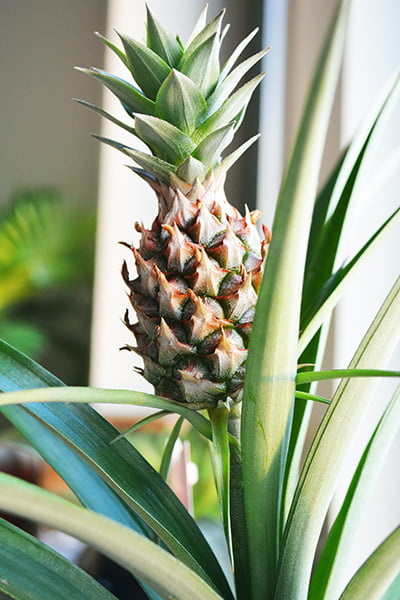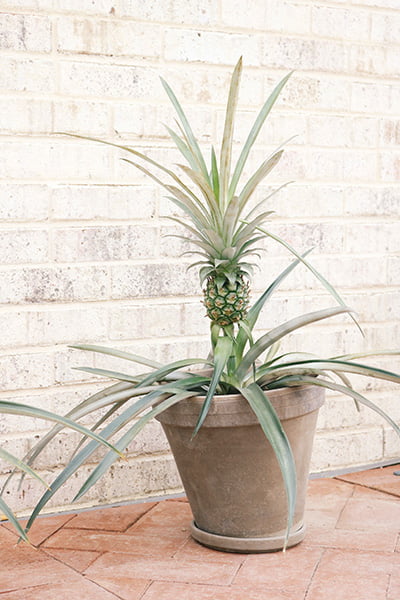Are you tired of the same old store-bought pineapples that taste bland and lack the juicy sweetness you crave? Why not take matters into your own hands and grow your very own pineapple at home? Not only is it a fun and rewarding experience, but it also guarantees you'll have the freshest, most delicious pineapples right at your fingertips.
Pineapple plants are easy to care for, and some varieties are well suited to grow indoors! Whether your aim is growing pineapples to eat or simply enjoying the cascades of spiky leaves, we'll tell you everything you need to know to grow your pineapple plant. So put on your gardening gloves and get ready to embark on a tropical journey that will leave your taste buds in paradise!
What Are Pineapple Plants?
Pineapple plants, like other Bromeliads, are native to the tropical environment of Central and South America. Most members of the Bromeliad family are epiphytic, meaning that they grow on trees rather than in soil, but the pineapple plant is unique in that it requires soil to grow.
Most pineapple plants sold in nurseries and greenhouses are dwarf, mini, or ornamental. While these pineapple plants are adorable, they do not produce edible pineapple. But you can grow your own pineapple plant by planting any store-bought pineapple!
Pineapple Plant Care Requirements
Light
Your pineapple plant needs as much bright light as you can give them! Place this tropical plant in a sunny spot with at least six hours of full sun. While pineapple plants can handle direct sunlight, the leaf tips can scorch and turn brown if the sunlight is too harsh. If this is the case, move your pineapple plant to a location that still receives plenty of sunlight but as indirect light.
Water
This tropical fruit plant needs lots of water. This is particularly true if you want your plant to flower regularly and produce fruit rather than just showy cascades of leaves.
Water your pineapple plant once a week, always checking the soil first to be sure that it's dry. It's important to keep the soil moist but not soggy. Because of the unique shape of this plant, it can be tricky to get water down to the soil. Using a long-necked watering can help you direct the water, and the leaves themselves will help funnel the water down to the base of the plant.
Temperature
Pineapple plants like warm temperatures! The ideal temperature range is between 65 and 95 degrees Fahrenheit. If you're growing your plant outdoors in a pot, you'll need to bring it inside when the overnight temperatures dip lower than 65 degrees Fahrenheit.
If your plant needs help indoors and your thermostat is set to an appropriate temperature, check that your pot isn't placed by drafty windows or air vents. The temperature in these areas may be cooler than you realize!
Humidity
It's important to keep the humidity high for the pineapple plant to thrive. This can be tricky if your pineapple plant is grown indoors. Here are some ways to help boost the moisture in the air around your plant:
Spritz your plant
Spritz the plant leaves regularly with water using a spray bottle.
Place the pot on a pebble tray
Fill a tray with pebbles, then fill it with water - but take care that the water does not come up over the top of the pebbles! As the water evaporates from the pebble tray, it will boost the humidity level around the plant set on top of it.
Place In Bathroom
Grow your pineapple plant in the bathroom, where the moisture in the air creates a humid environment.
Soil
The pineapple plant isn't picky about soil, and any type of potting soil should work well. It needs to be well draining, and your plant will grow best if you add extra peat moss (for moisture retention) and perlite (for aeration). You can also use premixed succulent or cactus soil.

Fertilization
During the growing season of the spring and summer months, it's important to fertilize a pineapple plant monthly. Use a balanced fertilizer, diluted to half strength. Avoid concentrated fertilizers, as they can burn the plant, and instead, use a fish emulsion or seaweed extract. If you use compost or manure as fertilizer, give the plant good watering to help the nutrients spread down into the soil.
Propagation
Once a plant produces pineapple fruit, it will start to decline. It's important to propagate your mother plant if you want to continue enjoying pineapple plants! There are two ways to do it - from baby plants or by planting the top of ripe fruit.
Planting Pineapple Slips
A pineapple plant will naturally set out new baby plants around its base, and if you leave them attached to the main plant, they will start to grow their own roots. Then, it's simple to cut away a baby plant using a sharp knife and replant them in a pot of its own.
Planting A Pineapple Top
Choose fruit with healthy green leaves. Opt for an unripe fruit with fresh leaves over a ripe fruit with leaves starting to droop.
Use a twisting motion to separate the spiky top from the fruit. It's best not to use a knife for this because you'll likely leave too much fruit pulp, which can result in rot.
Remove a few lower leaves from the crown's stem to better expose the stalk. You may see tiny roots already growing!
Plant the stem stalk into a pot of soil, burying the stalk completely but leaving the base of any remaining leaves uncovered.
Set your new plants in a location with direct sun, and keep the soil moist. As the plant grows, it will produce edible fruit within two to three years.

Common Problems With Pineapple Plants
Pests
Pineapple plants are likely hosts for mealy bugs, scale, and mites. All pest infestations can be handled by washing the leaves with soapy water, rinsing thoroughly, then treating the plant with neem oil.
Rot
Your pineapple plant may show signs of heart rot. This fungus causes the central leaves to turn black, and it is caused by excess moisture. Check that your soil is draining correctly, and apply a fungicide to the center of your plant.
Avoid overwatering your pineapple, as root rot can occur and ultimately can lead to plant death.
Is Pineapple Plant Pet Friendly?
No, the leaves and immature fruit of the pineapple plant are toxic to pets and can cause stomach upset and throat irritation.
